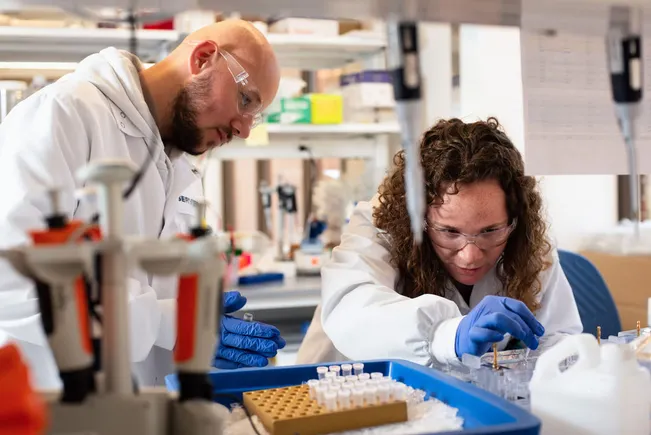Relentless innovation: Bold exploration in advancing therapeutic options for every patient, every discovery


On the heels of the BIO International Convention and as I reflect on the passion for innovation that drives this industry, one truth I keep coming back to is this: there is the potential for failure in drug development, but we cannot let that deter us. Developing therapies is a grueling, difficult process, one that includes significant risk, especially in the rare disease space. Servier believes that no disease is too challenging to be addressed and no patient population is too small to benefit. Our strategic approach is about advancing science to benefit patients most in need of new therapies.
As a private company led by a non-profit foundation, Servier is uniquely positioned to make investments that prioritize patients. This independence allows us to focus on cutting-edge science that supports our mission to drive therapeutic progress. Unlike publicly traded companies, we are not beholden to shareholder returns and the associated financial pressures. While tackling a disease with a small patient population may deter other pharmaceutical companies, we have a long view on research and strategy that enables us to pursue bold paths, seeing each patient as a person who is urgently in need of new therapeutic options. The success of this approach is reflected in our track record of bringing these medicines to market.
We have built a reputation as leaders in oncology by embracing the challenges of scientific discovery head-on and recognizing that innovation is needed for the most difficult-to-treat cancers. And while this may pose a barrier to others, we are unfazed by fear of the unknown or of failure. For some types of IDH (Isocitrate dehydrogenase)-mutant hematologic malignancies and solid tumors, no new treatment options had been introduced in decades. A focus on targeted treatment options, including IDH mutations, is the foundation of our acquisition strategy, which centers on oncology and expanding our scientific capabilities in precision medicine and cancer metabolism. The combination of this strategy, our approach to discovery and our corporate structure have been key to helping unlock novel therapeutic possibilities.
We’ve established ourselves as the leaders in treating rare forms of IDH-mutant cancers. Over the past three years, we have received three regulatory approvals in this space, one of which is a dual IDH inhibitor, targeting both IDH1 and IDH2 enzymes, that represents the first major treatment advancement in more than 20 years for certain types of brain tumors.
Our work in IDH-mutant cancers is not done yet. We continue to evaluate our investigational treatments for small patient populations in clinical trials. To do this effectively, working closely with the FDA and other regulatory agencies, as well as patient advocacy groups, is essential. Regulatory alignment is key to defining critical factors and expectations related to trial endpoints and design, as well as to help determine eligibility for key programs such as Orphan Drug Designation and Breakthrough Therapy Designation. Relationships with advocacy are critical to help with key logistical components such as patient awareness, recruitment, retention and even site selection. Alongside these aspects, advocacy involvement brings community credibility and can help ensure the trial has the patient experience at its core, with an approach that is mindful of ways to ease patient burden.
We have ongoing trials in patients with chondrosarcoma, a rare and aggressive bone cancer with limited treatment options, cholangiocarcinoma (CCA), a rare and aggressive form of bile duct cancer and myelodysplastic syndromes (MDS), a form of cancer in which some blood stem cells in the bone marrow are abnormal. We also have ongoing trials in acute myeloid leukemia, glioma as well as other indications.
IDH is not the only mutation for which we are pursuing treatments. Recently, we announced that Servier has acquired full rights to a Phase 1 asset with best-in-class potential targeting RAS mutations and RAF alterations in solid tumors, including non-small cell lung cancer (NSCLC). We are constantly pursuing opportunities to expand our oncology pipeline through licensing late-stage assets in hematology and solid tumors, particularly looking at precision medicine to help make a difference for patients. We also are looking to partner in select oncology and neurology disease areas with a focus on external assets at preclinical and early clinical stages. Our commitment to scientific progress is not determined by the number of patients who are affected but, rather, by the medical need and potential for transformation in patient’s lives.
In addition to targeting oncogenic driver mutations, we are pioneering precision therapies that address genetic vulnerabilities involved in the metabolic reprogramming of cancer cells. Our MAT2A program, for instance, focuses on meeting the needs of patients with a homozygous deletion of the gene encoding methylthioadenosine phosphorylase (MTAP). MAT2A has been identified as a synthetic lethal target in cancers with this deletion and the discovery of the unique relationship between MAT2A and MTAP has led to the development of MAT2A inhibitors as potential anti-cancer treatments.
We are now taking our patient-centered approach in oncology and moving into rare neurological disorders, another therapeutic area where innovation has been limited. The decision to expand our focus was based on careful consideration of the unmet need, our organizational capabilities and our track record of success in oncology precision medicine. Rather than shying away from neurological disorders because of the complexities of the underlying biology, we are leveraging our expertise in ASOs (antisense oligonucleotides), small molecule design and antibodies to directly tackle those challenges. By targeting the pathological alterations that cause diseases, we are working to develop precision therapies for patients living with refractory epilepsies, certain neuromuscular disorders and certain abnormal movement disorders – all of which represent small patient populations. We’ve learned that where patient populations are small, advocacy groups are often mighty. By working closely with these organizations, we can better understand the patient needs and develop treatments more effectively. We aim to change the treatment paradigm for those conditions just as we have for IDH-mutant cancers.
As we look ahead to the future of innovation, we know that we cannot do this alone if we want to realize the possibilities. Through partnerships, we are tapping into the power of big data and artificial intelligence (AI) to advance innovative treatments. Oncology and Neurology are at the forefront of advances in AI, with applications ranging from detection to diagnosis to treatment. Whether it be screening billions of novel compounds in just days or creating digital twin simulations of disease progressions, advanced technologies are having a profound effect on how we do research and we’ve only begun to scratch the surface.
While the drug discovery and development ecosystems continue to evolve and change, our commitment to patients with cancer and neurological disorders will never change. We will not shy away from complex science or be deterred by the possibility of failure. We will continue to innovate for patients and their families.
This post has been syndicated from a third-party source. View the original article here.




